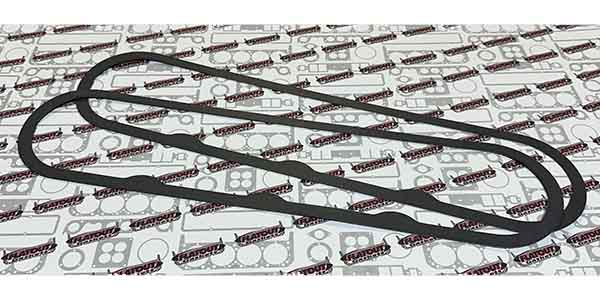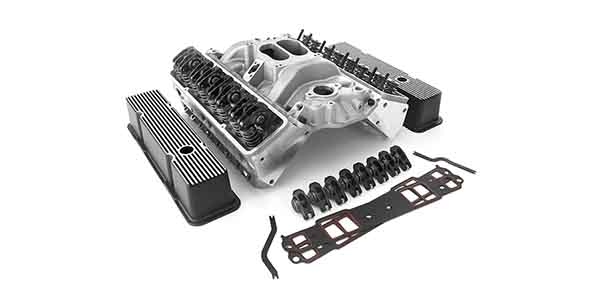At first blush, using fasteners properly seems like a straightforward task: tighten them to spec and all is well. But in reality, there are many nuances in the selection and application of fasteners that can make the difference between a well-built engine and a candidate for self-destruction.
The first thing to understand is that fasteners act much the same as a spring, given the physics of stretch and rebound. A stud or bolt must be stretched to produce clamping force. For example, a typical 3/8” connecting rod bolt will need to be stretched some .006” to provide 10,000 lbs. of force.
Applying the torque required to achieve the desired preload can be done in any of three methods; (1) using a torque wrench, (2) employing the “torque angle” method where the fastener is taken to a predetermined position (often done with robotic equipment by OEMs) and the most accurate method, (3) relying on a stretch gauge. However, having access to measure stretch is generally limited to con rod bolts, as most engine fasteners are installed “blind.”

Given that torque wrenches are the most widely used, it’s important to test them regularly. “We have long offered free torque wrench testing at NHRA events and discovered that a large number of racers were using inaccurate equipment,” says Bob Florine from Automotive Racing Products Inc. (ARP). “Some torque wrenches were off by as much as 30 percent. They are delicate instruments that must be handled properly, generally should not be used to ‘back off’ the torqued fastener and periodically checked for accuracy.”
By far, the most important factor in properly assembling an engine is the phenomenon known as “preload scatter.” You set your torque wrench to a predetermined level, apply torque incrementally, and assume all is well when the wrench goes “click!” Alas, a great deal of the energy exerted in tightening the fastener merely overcomes friction from thread engagement, the underside of the bolt head or nut, and the fastener lubricant itself (oil, moly, “peanut butter,” diesel lube, etc. all have different frictional values). Typically, the desired preload is not achieved. What’s more, the amount of inherent friction can vary from fastener to fastener, amplifying “preload scatter.” You can have significantly different preloads in adjacent fasteners, which in the case of head studs or bolts, can cause cylinder bore distortion, adversely affecting ring seal and most importantly, can result in a blown head gasket due to improper preload or clamping load.

The common practice over the years to mitigate friction has been to ‘cycle’ the fastener (torque, loosen, re-torque) up to a half-dozen times to ensure proper preloading. Research and development has created a better way. “Our engineers have spent years utilizing sophisticated testing equipment to develop a very effective, consistent fastener lubricant called ARP Ultra-Torque®,” says Florine. “It provides the desired preload within 5 percent on the first (or any subsequent) pull. Obviously, we feel this fastener lubricant can be a great time saver for engine builders in both the machining and assembly phases.”
Most engines built since the advent of electronic fuel injection are factory assembled using TTY (Torque To Yield) fasteners and automated equipment. The fasteners are engineered to be yielded, and typically preloaded to 95-120% of said yield. As they have been yielded and lost their resiliency, the factory TTY bolts should NEVER be re-used.

“Prior to assembling an engine it is good practice to measure each rod bolt and make note of its length,” Florine suggests. ”Our catalog contains a logbook format that’s easily copied.”
After the engine has been disassembled (normal rebuild cycle for racing engines) the rod bolts should again be measured in their relaxed state. If any has permanently stretched .001” or more it has been yielded and should not be used again. They should also be examined for any signs of galling, corrosion or deformation. These are also cause for replacement.”
It’s important to note that factory TTY fasteners have virtually no margin of safety. While they are sufficient for coping with the initial build, when additional strain is placed on an engine in the form of performance enhancements the OEM fasteners are often not up to the task and will fail. Without naming names, a certain diesel engine has left a trail of blown head gaskets from coast to coast, thanks in part to owners amping up performance and the TTY head bolts simply not able to cope with the added power.

“ARP engineers its fasteners to exceed factory specification loads by 25 percent or greater while installed at 75 percent of their yield strength,” says Florine. “This increases the load-carrying capabilities and leaves enough margin to ensure re-use of the fastener.”
The question of “bolts vs. studs” is often raised, and for the most part it’s a slam-dunk in favor of studs. As studs are typically inserted “finger tight” in the block, and when torque is applied to the nut it essentially pulls the stud from both ends delivering an even amount of force over the length of the stud. As opposed to a bolt which is literally twisted into the block while stretching it to the desired preload, there’s far less force exerted on the block threads —especially important when aluminum blocks are employed.
“In years past there might have been some question about clearances in tight engine compartments, but with hex-broaching of studs there are no issues given the ease of installation and/or removal,” explains Florine. “Studs provide the added benefit of accurately positioning gaskets and guiding the components into place. Centerless grinding of our studs after head-treat ensures perfect concentricity, which enables cylinder heads, caps, etc. to literally ‘drop’ into place.”

Likewise, accessory studs can make it easier to deal with oil pan, valve cover and exhaust gaskets ‹and also assure proper component positioning. Polished stainless steel studs (which won’t rust, chip or peel like chrome plated fasteners) come with a “nut starter nose” to facilitate installations in the tightest of quarters. They are also available in black oxide finished 8740 chrome moly, for those who prefer a more subtle approach.
Though fasteners are often taken for granted, using quality high performance studs and bolts can provide engine builders with important “insurance” toward long-term reliability.
Special thanks to Automotive Racing Products, Inc. (ARP), Ventura, CA, for this information: arp-bolts.com.















